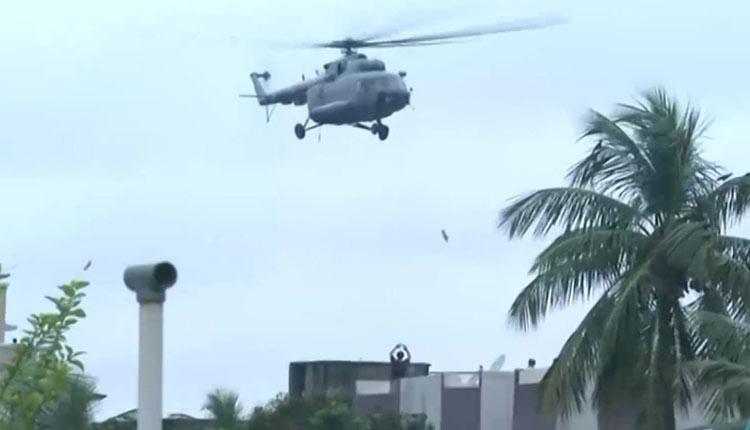Bihar Floods: IAF Helicopters Air Drop Relief Material, more than 10 lakh Affected

Image Courtesy: ANI
Patna: With floods ravaging parts of Bihar, three Indian Air Force helicopters on Saturday airdropped relief materials in the worst-hit districts of Darbhanga, East Champaran and Gopalganj.
More than a million people (10 lakh) have been affected by the floods in Bihar. The disaster has claimed the lives of more than a dozen people, washed away hundreds of thatched and mud huts and severely damaged brick houses, roads, bridges and standing crops worth crores of rupees.
Amid the worsening COVID-19 pandemic, thousands of people in Bihar have been forced to flee from their homes as flood water entered hundreds of villages. Many of them have been living under the open sky. The rising water levels in several rivers is threatening to inundate many other villages in the coming days.
Authorities in the flood-hit districts have asked those living in vulnerable and low-lying areas to shift to safer places after water levels rose in the rivers. The state government has asked engineers and district officials to keep a round-the-clock vigil on the situation.
On Friday, the state government sought helicopters from the Indian Air Force to airdrop relief materials and rescue those affected by the deluge.
“The flood situation has worsened in the state. Government agencies are on alert and have started airdropping relief materials from Saturday in IAF helicopters. NDRF and SDRF teams have been deployed for relief and rescue operations in the flood affected areas,” said Bihar Disaster Management Minister Lakshmeshwar Roy. He said that 22 NDRF and SDRF teams have been engaged in relief and rescue operations.
As per official data from the Disaster Management Department, 9,60,831 people have been affected by floods in ten districts of the state as of Friday evening. The number of those affected is increasing by the day. As of July 18, the number of those affected by the flood was 2.92 lakh. “We have received information on Saturday which clearly shows that the number of affected people crossed 10 lakh. Official data will be made public after 6 p.m. today,” an official said.
About 93,891 people have been rescued from marooned villages so far and 12,023 people are staying in 21 relief camps in the state. Unofficial figures put the number of those affected at more than 30 lakh.
Fear of floods forced the poor, including landless farm labourers, small farmers and others to take shelter on high-rise river embankments, on national highways, in school buildings and at other safer spots.
All the major rivers in Bihar are in spate after heavy rains in their respective catchment areas in neighbouring Nepal and in Bihar. Rivers breached their embankments at several places, inundating hundreds of villages in different districts, and posing a serious threat to others. It forced people to flee their homes, and they are now struggling to survive. “Pressure on embankments has increased after the water level rose in rivers after heavy rains and regular heavy discharge of water into the Koshi and Gandak rivers in the last six days,” an official from the Water Resources Department told NewsClick.
Floodwaters have submerged large areas in over a dozen districts in north Bihar. So far, 10 official deaths have been reported, officials said.
Train services were disrupted between Darbhanga and Samastipur after flood water submerged a railway bridge on the line. Divisional Railway Manager of Samastipur railway division, Ashok Maheshwari, said the routes of some trains were changed in view of the situation.
According to officials, crops worth crores of rupees were damaged and road links to several places had been snapped.
What raised eyebrows is that Bihar Chief Minister Nitish Kumar is yet to undertake a survey of the flood-affected districts where thousands of people have been displaced and are battling for survival. Opposition leaders have taunted him for neglecting the affected people and urged him to at least survey the areas by air if not on the ground.
Bihar’s Water Resources Minister, Sanjay Jha, who is considered close to Nitish Kumar, had undertaken an aerial survey of the flood affected districts along with top officials of his department and the disaster management department on Friday.
Bihar Opposition leader Tejashwi Yadav also appealed to CM Nitish Kumar to at least conduct an aerial survey of the flood-affected areas.
According to official figures of the WRD, Bihar is the most flood-affected state in India, accounting for close to 17.2% of the total flood-prone area in the country. Out of its area of 94.16 lakh hectares, 68.80 lakh hectares (76% of North Bihar and 73% of South Bihar) is flood-prone. At present, 28 out of 38 districts in the state are flood-prone.
Flood management work that can be carried out includes the construction and maintenance of embankments, revetment in selected portions of river banks, land spurs and other necessary flood-protection work. A large part of the rivers’ catchment areas fall in the glacial regions of the Himalayas. Thus, remedial measures for flood protection in Bihar are critical.
As a long-term measure, the construction of storage reservoirs and extensive watershed treatment in the upper catchment areas of rivers is considered essential. As a short-term fix, the construction of embankments along the rivers was done; by constructing about 3,745.96 kms of embankments, around 36.46 lakh hectares of area has been brought under a reasonable degree of protection.
However, existing embankments are under increasing pressure due to the rise in the river-bed levels due to the heavy silt brought down by the rivers from Nepal. Due to an abnormal change in river courses, anti-erosion work for the protection of embankments and essential flood-fighting work, is imperative each year. However, due to a delay in the work this year, the flood situation may take a turn for the worse.
Get the latest reports & analysis with people's perspective on Protests, movements & deep analytical videos, discussions of the current affairs in your Telegram app. Subscribe to NewsClick's Telegram channel & get Real-Time updates on stories, as they get published on our website.





















